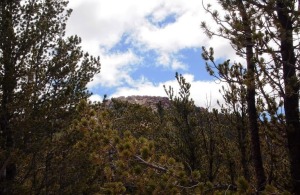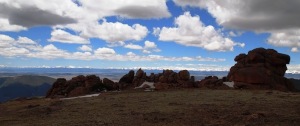
For travelers visiting Colorado in the summertime, the ultimate hiking excursion is to make it to the peak of one of the 53 “14ers” whose summits are at least 14,000 feet in altitude. Some are reachable by car (Evans) or by train (Pike’s) but most of them require a healthy uphill march. No matter their difficulty, every 14er is on the map and well-trodden. Especially during the summer high season, you’re bound to run into a good amount of traffic, especially on the most popular 14ers that are closer to Denver and the Front Range. For those who are looking for a fantastically scenic and satisfying summit hike, but who aren’t married to the “14er” brand, plenty of other peaks offer a more secluded excursion. In June I discovered Bison Peak in the Lost Creek Wilderness, and it is now one of my favorite peaks in the state. The hike follows an out-and-back trail of 11.27 miles round trip, taking 6 to 8 hours to complete. Summit elevation is 12,431 feet, for a total altitude gain of 3,691 feet. Difficulty is Class I - easy to moderate. Open year-round.

Here are a few things I love about Bison Peak:
- Bizarre, beautiful rock formations on top. Just past the treeline of the mountain, you’ll start to see the billowing boulders of Bison Peak. Round and layered, they tease the imagination with what they resemble. Some say they look like a charging herd of bison if you squint your eyes, which is where the peak’s name is said to have originated. To me they looked like giant cairns, almost too deliberate-looking to have happened by chance. Bring a camera -- this is perhaps one of Colorado’s most photogenic high points.
- Proximity to Denver. Another advantage of Bison Peak is that you can reach it easily from Denver, without having to deal with the 1-70 corridor. Following Interstate 285 southwest, you’ll pass the town Bailey and Kenosha Pass, reaching the Lost Creek Wilderness Area in less than two hours. Still an all-day trip, but no need to camp or wake up at the crack of dawn.
- Tallest in its range. At 12,431 feet, Bison Peak is the tallest peak of the Tarryall Mountains, which means you still get the “top of the world” feeling at the summit. Look around for a 360 degree panorama of clouds and peaks for as far as the eye can see.
- Not a 14er. The fact that Bison Peak doesn’t appear on the 14er or even the 13er radar makes it a well-kept secret. I went on a late spring day in June with great weather, and still there were only one or two other groups the whole day. Its stature also makes it a great “warm up” hike for those who aren’t quite ready or acclimated for a 14er.

